How to install Tomcat9 on Ubuntu 16.04
To install Tomcat9 on Ubuntu 16.04
Apache Tomcat is an open source web hosting server and servlet container from Apache Software Foundation. It executes Java servlets and renders Web pages for the Java-based web application. In fact, Apache Tomcat is one of the most popularly used web servers among the java developers. It is really simple to install Apache Tomcat on Ubuntu 16.04, and this article covers the ground on the same process.
Installing Tomcat9
It is really very essential to install Java, so make sure you run the following command.
root@linuxhelp11:~# apt-get install default-jdk
Reading package lists... Done
Building dependency tree
Reading state information... Done
The following packages were automatically installed and are no longer required:
gnome-software-common libgtkspell3-3-0
Use ' sudo apt autoremove' to remove them.
The following additional packages will be installed:
ca-certificates-java default-jdk-headless default-jre default-jre-headless
fonts-dejavu-extra java-common libgif7 libice-dev libpthread-stubs0-dev
libsm-dev libx11-dev libx11-doc libxau-dev libxcb1-dev libxdmcp-dev
libxt-dev openjdk-8-jdk openjdk-8-jdk-headless openjdk-8-jre
openjdk-8-jre-headless x11proto-core-dev x11proto-input-dev x11proto-kb-dev
xorg-sgml-doctools xtrans-dev
.
.
.
Updating certificates in /etc/ssl/certs...
0 added, 0 removed done.
Running hooks in /etc/ca-certificates/update.d...
done.
done.
Once it is installed, you shall check the version of Java which you’ ve just installed. Run the following command for the same purpose.
root@linuxhelp11:~# java -version
openjdk version " 1.8.0_151"
OpenJDK Runtime Environment (build 1.8.0_151-8u151-b12-0ubuntu0.16.04.2-b12)
OpenJDK 64-Bit Server VM (build 25.151-b12, mixed mode)
Once it is done, you need to create a user for Tomcat. Run the command for that.
root@linuxhelp11:~# useradd -r tomcat9 --shell /bin/false
Then enter into the opt location through the following command.
root@linuxhelp11:~# cd /opt
Now, you shall download tomcat9 package by using the wget command in the following manner.
root@linuxhelp11:/opt# wget http://www-eu.apache.org/dist/tomcat/tomcat-9/v9.0.1/bin/apache-tomcat-9.0.1.tar.gz
--2017-11-19 05:39:43-- http://www-eu.apache.org/dist/tomcat/tomcat-9/v9.0.1/bin/apache-tomcat-9.0.1.tar.gz
Resolving www-eu.apache.org (www-eu.apache.org)... 195.154.151.36, 2001:bc8:2142:300::
Connecting to www-eu.apache.org (www-eu.apache.org)|195.154.151.36|:80... connected.
HTTP request sent, awaiting response... 200 OK
Length: 9397803 (9.0M) [application/x-gzip]
Saving to: ‘ apache-tomcat-9.0.1.tar.gz’
apache-tomcat-9.0.1 100%[===================> ] 8.96M 9.51MB/s in 0.9s
2017-11-19 05:40:35 (9.51 MB/s) - ‘ apache-tomcat-9.0.1.tar.gz’ saved [9397803/9397803]
Then, extract the downloaded file as follows.
root@linuxhelp11:/opt# tar -zxf apache-tomcat-9.0.1.tar.gz
After that, you need to create a symbolic link for extracted directory in the following manner.
root@linuxhelp11:/opt# ln -s apache-tomcat-9.0.1 tomcat-latest
Later, you need to change the ownership of the extracted directory.
root@linuxhelp11:/opt# chown -R tomcat9: tomcat-latest apache-tomcat-9.0.1
Once it is done, you need to create a user for manager and admin in tomcat-user file. Using the vim editor, create a new file.
root@linuxhelp11:/opt# vim tomcat-latest/conf/tomcat-users.xml
And, in that file, you need to add the following lines.
< role rolename=" manager-gui" /> < role rolename=" admin-gui" /> < user username=" admin" password=" password" roles=" manager-gui,admin-gui" />
Once the above part is over, you need to make an entry to allow the server. So open the file.
root@linuxhelp11:/opt# vim tomcat-latest/webapps/manager/META-INF/context.xml
And in that file, you need to give your server ip.
< Valve className=" org.apache.catalina.valves.RemoteAddrValve"
allow=" 127.d+.d+.d+|::1|0:0:0:0:0:0:0:1|< server ip > " />
You should also add your server ip in another location as well. And for that, go to the following location.
root@linuxhelp11:/opt# vim tomcat-latest/webapps/host-manager/META-INF/context.xml
And in that file, modify the server ip to yours.
< Valve className=" org.apache.catalina.valves.RemoteAddrValve"
allow=" 127.d+.d+.d+|::1|0:0:0:0:0:0:0:1|< server ip > " />
Next, you need to configure the daemon file to start and stop tomcat service. So, open the file.
root@linuxhelp11:/opt# vim /etc/systemd/system/tomcat.service
And add the following lines to it.
[Unit] Description=Tomcat9 After=network.target [Service] Type=forking User=tomcat9 Group=tomcat9 Environment=CATALINA_PID=/opt/tomcat-latest/tomcat9.pid Environment=JAVA_HOME=/usr/lib/jvm/java-1.8.0-openjdk-amd64 Environment=CATALINA_HOME=/opt/tomcat-latest Environment=CATALINA_BASE=/opt/tomcat-latest Environment=" CATALINA_OPTS=-Xms512m -Xmx512m" Environment=" JAVA_OPTS=-Dfile.encoding=UTF-8 -Dnet.sf.ehcache.skipUpdateCheck=true -XX:+UseConcMarkSweepGC -XX:+CMSClassUnloadingEnabled -XX:+UseParNewGC" ExecStart=/opt/tomcat-latest/bin/startup.sh ExecStop=/opt/tomcat-latest/bin/shutdown.sh [Install] WantedBy=multi-user.target
Once it is done, you need to reload the daemon as follows.
root@linuxhelp11:/opt# systemctl daemon-reload
Then, start the Tomcat service.
root@linuxhelp11:/opt# systemctl start tomcat
And, enable it as follows.
root@linuxhelp11:/opt# systemctl enable tomcat
Created symlink from /etc/systemd/system/multi-user.target.wants/tomcat.service to /etc/systemd/system/tomcat.service.
Now, open a browser and give localhost:8080 as the URL . The home page of Tomcat appears on your screen.
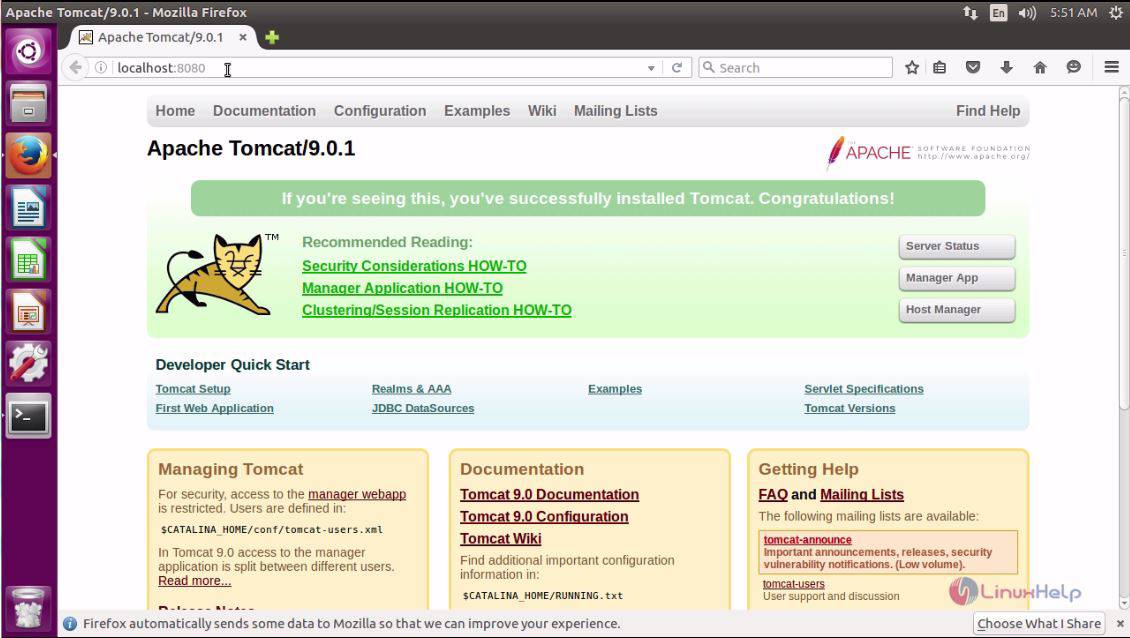
If you want to open the manager app, then click on it.
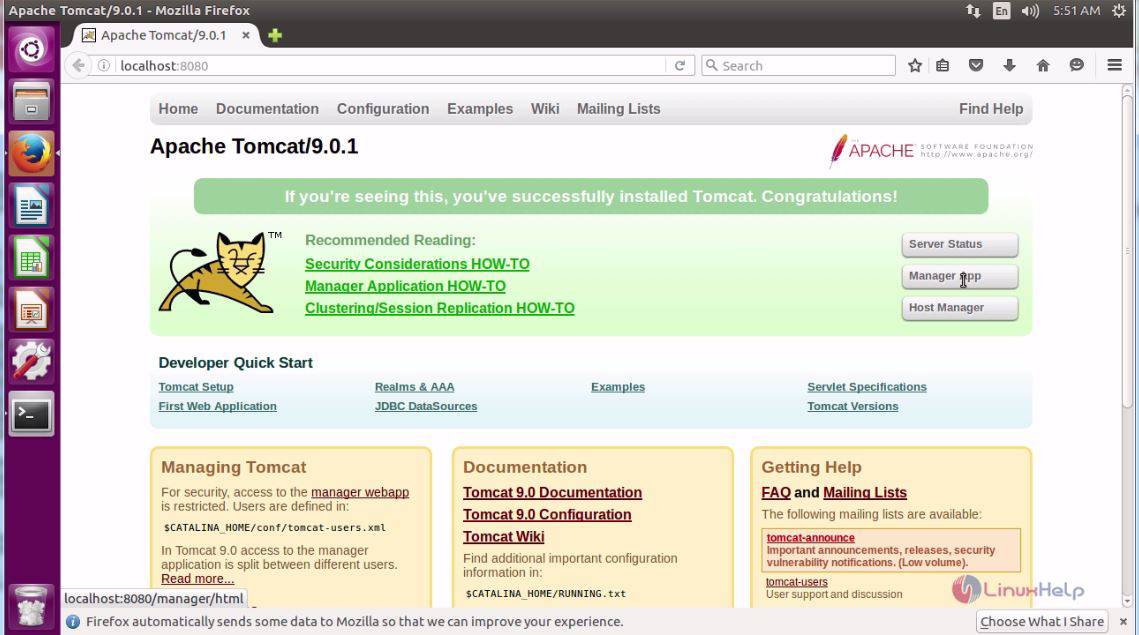
And give your login credentials in the popup that appears.
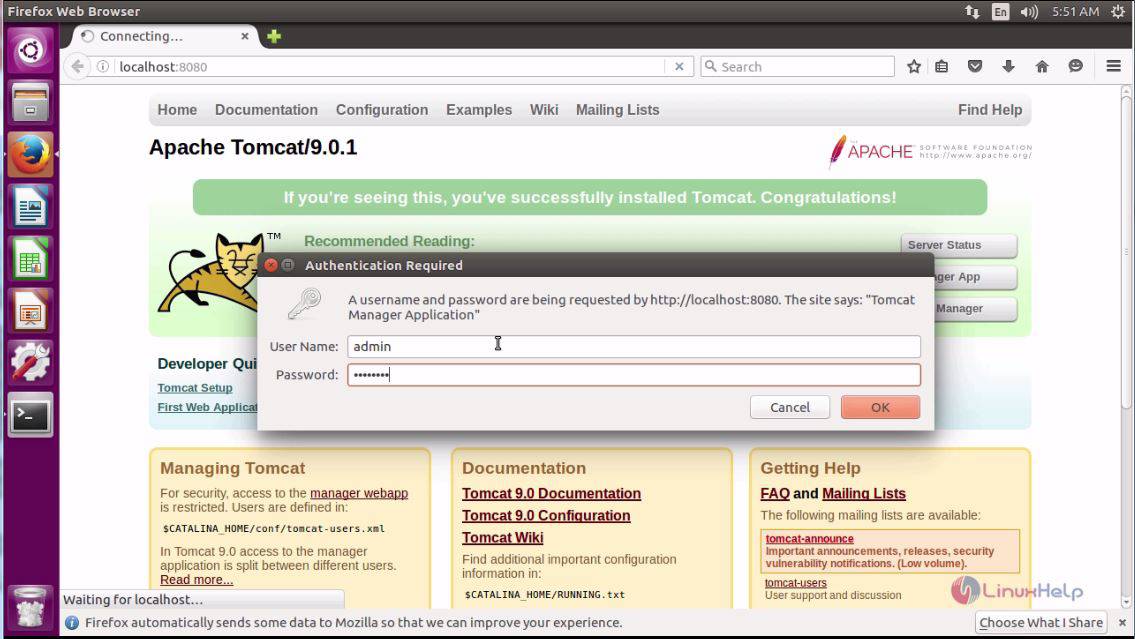
The Manager page of Tomcat now appears.

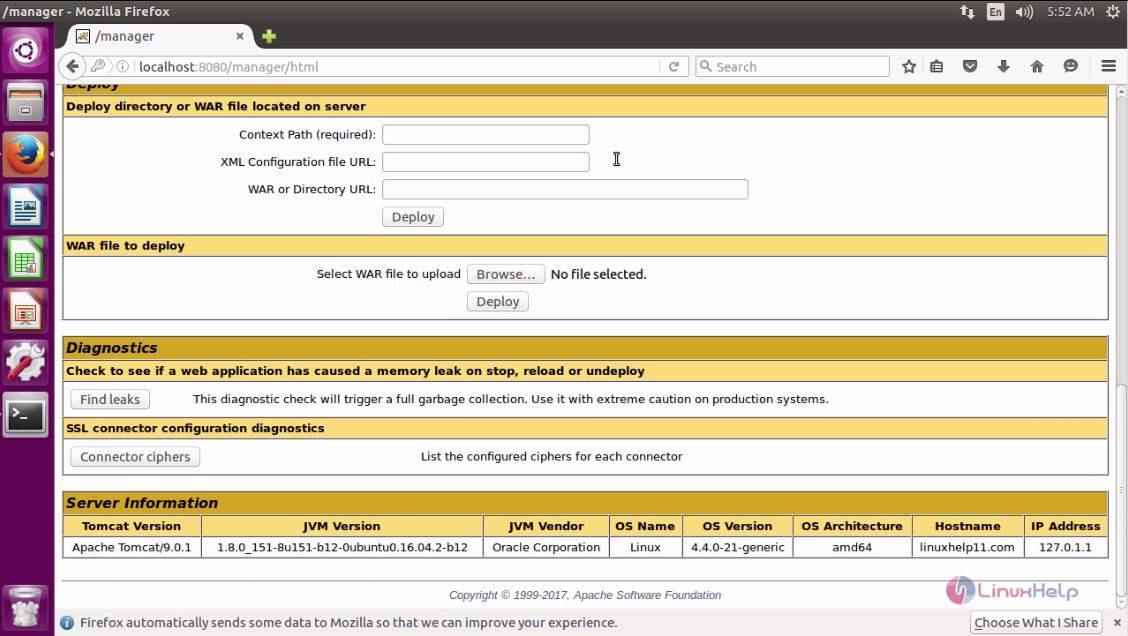
If you want to open the VirtualHost for admin panel, then click on Host manage.
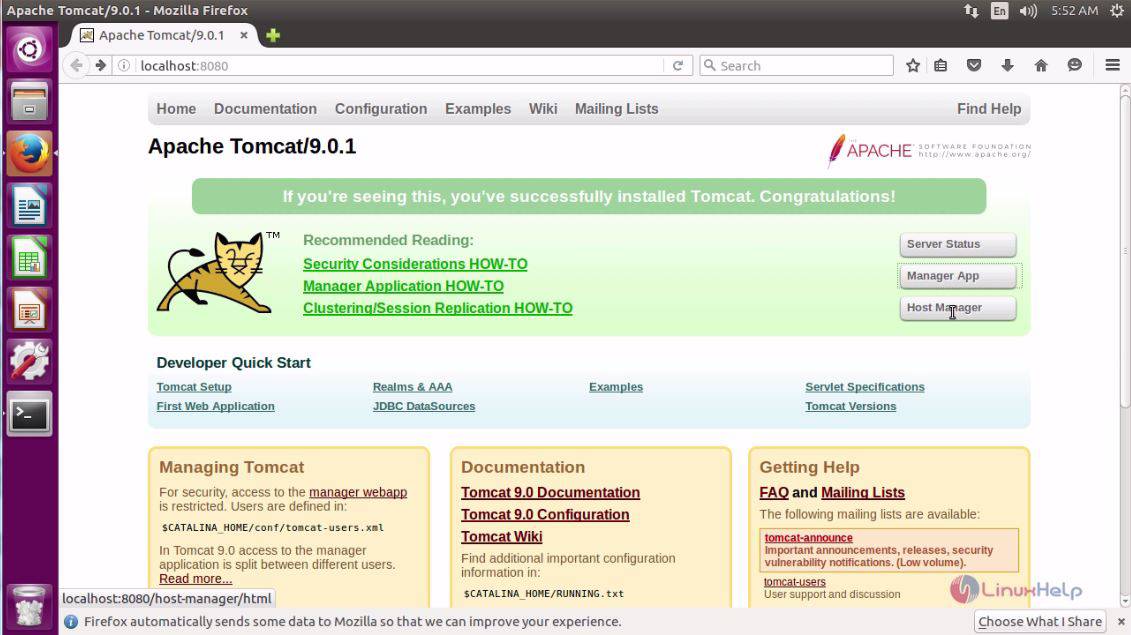
In that popup, give your credentials.
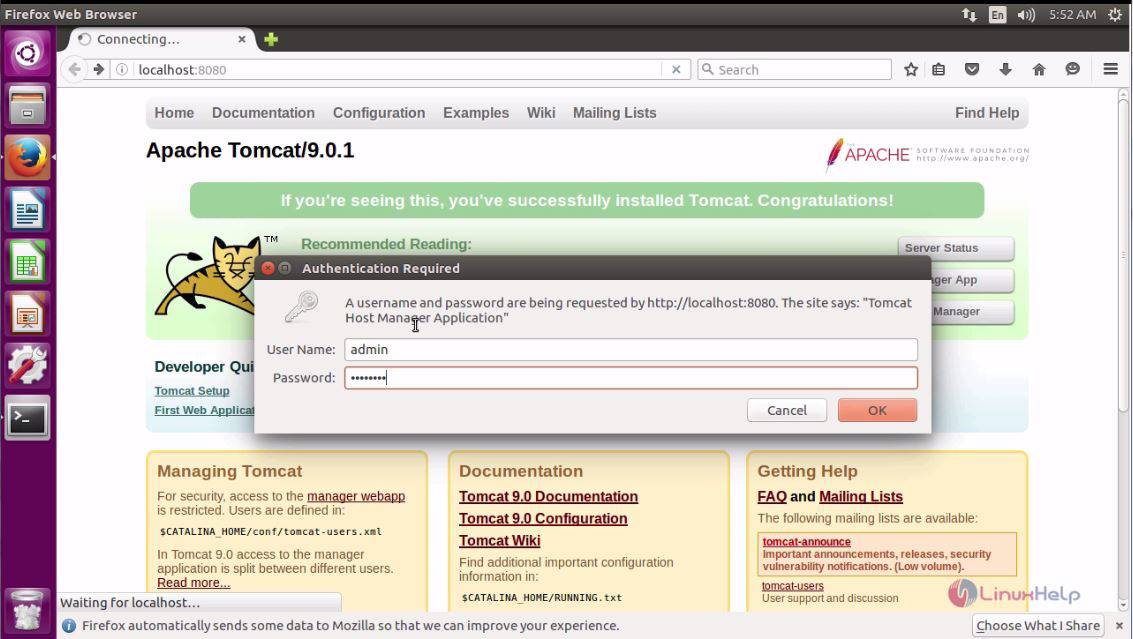
The Host page now appears.
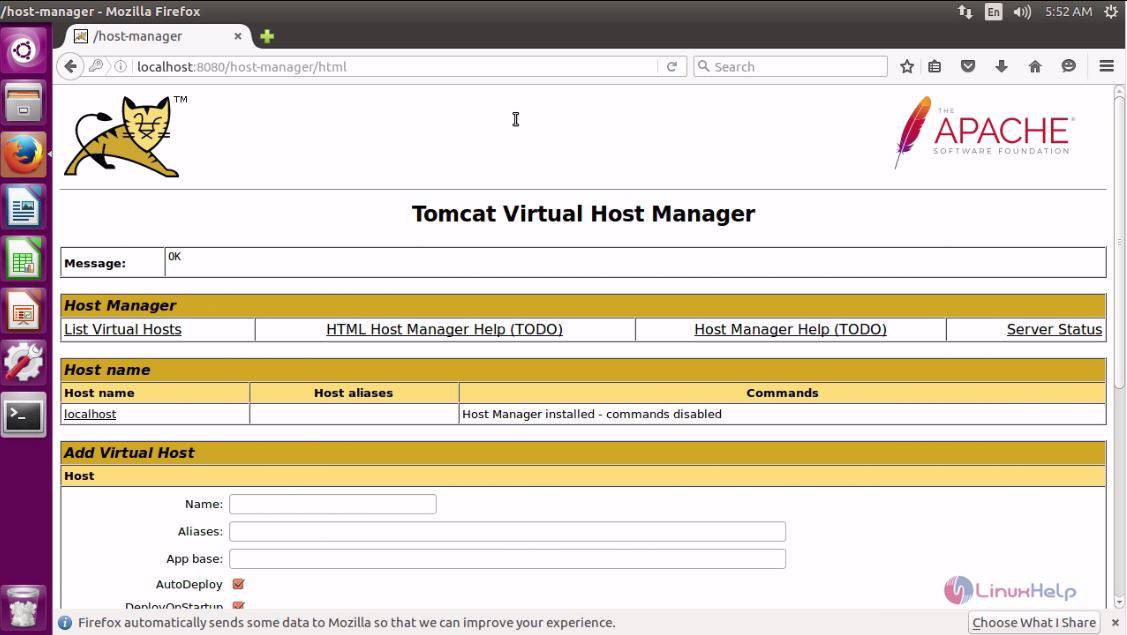
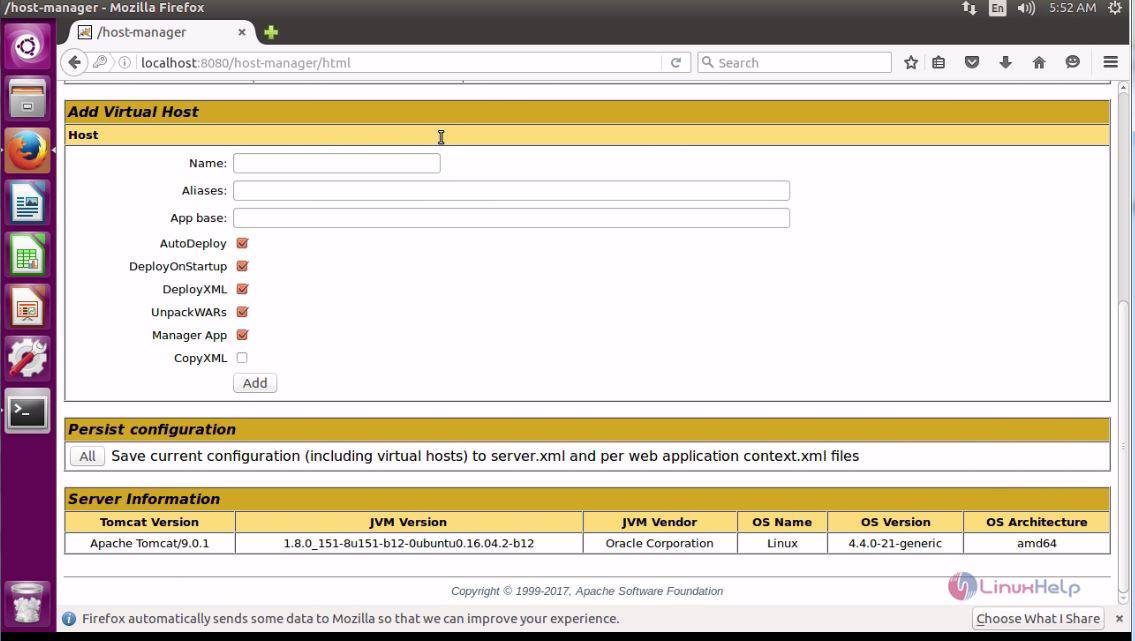
With this, the installation of Tomcat9 comes to an end.


Comments ( 0 )
No comments available